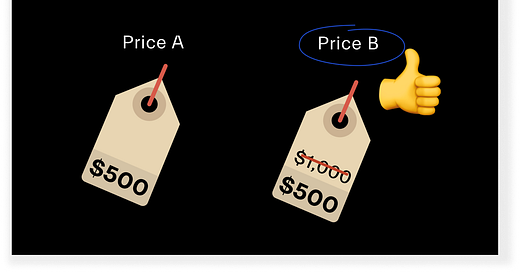Cognitive Biases Series: The Anchoring Effect in Pricing Strategies
How First Impressions Shape Perceived Value
A heartfelt thank you to my first 15 subscribers - my pioneering Behavioral Marketers.
I'm thrilled to have you on this journey as we explore the fascinating intersection of behavioral science and marketing.
I look forward to sharing valuable content and growing alongside you in this ever-evolving field.
Assuming the picture is referring to the same product, Price B will be seen as a somewhat better deal than Price A. The key concept here is how a deal is 'perceived' or felt to be better.
Anchoring is just one of the many cognitive biases that influence our decision-making ability.
This bias, when applied to pricing, relies on how much something feels like its worth based on the first price seen.
The Psychology of Anchoring
The idea of the anchoring bias originated in 1974 by Amos Tversky and Daniel Kahneman.
To illustrate the effectiveness of this cognitive bias, consider a famous example: A daughter who wrote a letter to her parents informing them about all the drastic negative things that had happened to her, such as getting pregnant, being hospitalized because of a dormitory fire, suffering a skull fracture, and becoming engaged to the bad boy in town.
You can imagine the horror the parents felt, only to later learn that none of these things were true.
The real reason she wrote was to inform them that she had failed her chemistry class. (She might have failed chemistry, but she gets an A in psychology!)
In comparison to all those alarming scenarios, failing a class was now perceived in a much less severe light, maybe even bringing a sense of relief to her parents.
If the daughter had simply told her parents she failed a class, she might have received a scolding.
This example perfectly demonstrates how anchoring can drastically change our perception of a situation, making the actual news seem far less troubling by comparison.
Another classic example comes from the book "Influence" by Robert Cialdini. One of his readers reported an incident at an airport.
A desk agent announced that the flight to O’Hare was overbooked and that passengers willing to take a later flight would be compensated with a $10,000 voucher.
This exaggerated amount garnered laughs from the waiting passengers. However, when the agent revealed the actual offer of a $200 voucher, there were no takers.
He had to raise the offer twice, to $300 and then to $500, before he got any volunteers.
Knowing the anchoring principle, if the agent had initially joked about a lower amount, say $2, before revealing the actual $200 offer, he might have gotten volunteers at the first price. Setting an initial high anchor ($10,000), the agent made a reasonable offer seem less appealing.
These examples illustrate how the first piece of information we receive becomes an anchor, and all future evaluations are based on this anchor.
Application in Different Pricing Strategies
Anchoring based on competitor combinations
A good example of this is GoHighLevel’s (GHL) pricing section:
GHL anchors their price against the slew of tools customers would have to combine to get the same level of features that GHL offers. The comparison shows how expensive these combinations can get, making GHL appear much more affordable.
Displaying the original price alongside the sale price
This one is a classic and we mostly see them in retail platforms such as Amazon.
Even though most buyers are now informed, the perception of an item being on sale is still effective.
This perception is especially powerful when combined with other influencing factors such as scarcity and social proof, which you’ll read about in future posts.
Using bundle pricing to anchor value perception
You can usually see this kind of strategy from course creators just like below:
They typically state how much each item in the bundle costs, effectively using the anchoring effect to make the bundled price (which is usually lower than the sum of all combined items) seem like a steal.
Introducing a premium option to make mid-range options more attractive
This is common in subscription-based services or products. We are familiar with this kind of format where the pricing pages usually displays 3 to 4 options.
Take a look at Shopify’s pricing page below:
Seeing the premium price tag as the anchor made the Advanced and Shopify options seem cheaper by comparison.
A Powerful Tool Added to your Arsenal
The anchoring bias is a powerful tool in a marketer’s arsenal. However, it’s important to remember that while this is proven to be effective, it should be used responsibly and to provide value to customers and other businesses.
As marketers, we should strive to use these techniques not just to increase profits, but to help customers make informed decisions that truly benefit them.
In your own marketing efforts, consider how you might apply these anchoring strategies.
Whether you're pricing products or services, creating bundles, or designing subscription tiers, remember that the first price you show can significantly impact how all subsequent prices are perceived.
Use this knowledge wisely to create pricing structures that feel fair and valuable to your customers while supporting your business goals.
📌 Practical Tip:
When negotiating about something, for example a raise in salary or closing a client deal, remember the anchoring effect. Start with a higher amount than what you expect to settle on. For example, if you want a $5,000 raise, ask for $7,000. This higher anchor sets the stage for negotiations, and the final offer may be closer to your desired amount.










